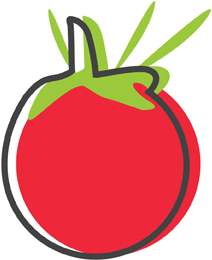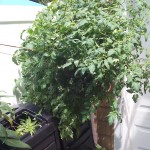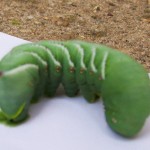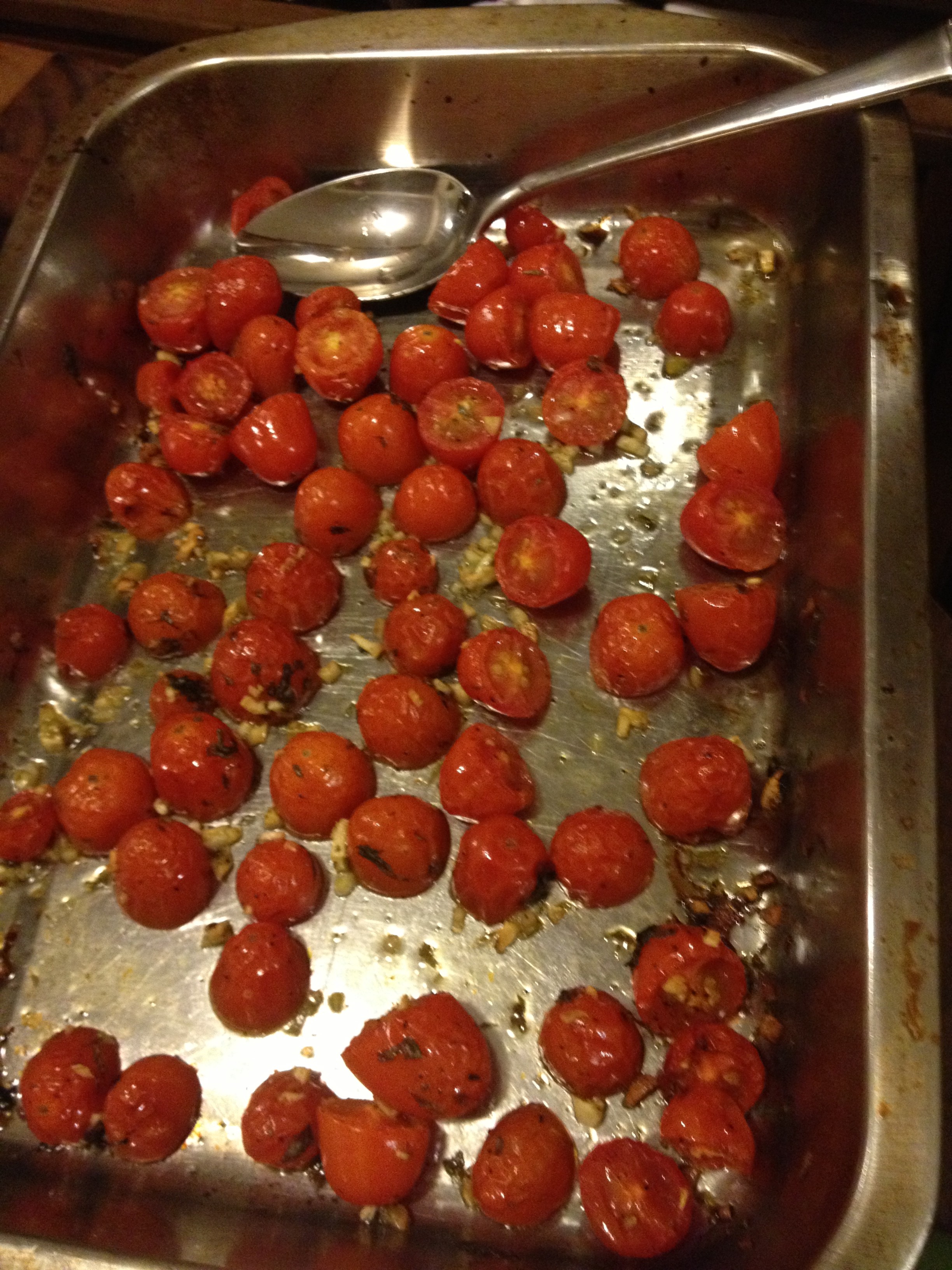by Paula D.
on October 1, 2025 3:12 pm in Gardening
In May, I discovered the most wonderful surprise in my garden —a peanut sitting right on top of the soil! It was split open, and a tiny sprout was starting to grow. I tucked it into the soil with my fingers and thought, imagine? It must have come from the pile of peanuts someone leaves for the pigeons and squirrels outside the Beach 91st Street Community Garden gate, almost every morning.
At our last monthly garden meeting, I went looking for the peanut plant but wasn’t exactly sure what I was looking for. Luckily, garden member Lucy was there. I told her about my little peanut experiment, and she immediately identified the plant in my plot—it had grown! It’s currently about three inches tall. I was overjoyed and started bombarding her with all the questions.

Georgia is the leading peanut-producing state in the U.S., accounting for over half of the total production, and get this, by U.S. Law, peanut butter must contain at least 90% peanuts to be labeled as such. The remaining 10% can consist of optional ingredients like salt, sweeteners, and hydrogenated vegetable oils.
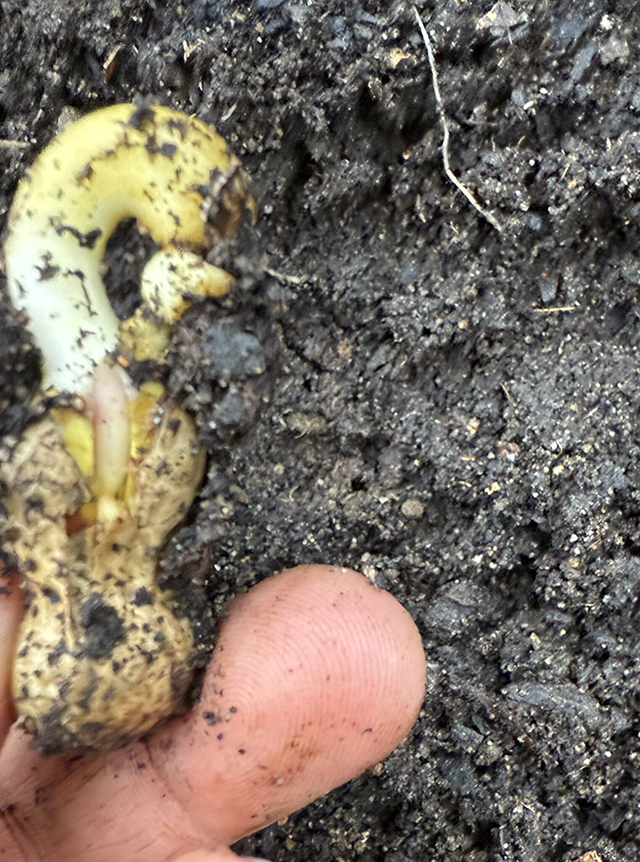
Peanuts are not nuts!! They are classified as legumes. A legume is in the pea family – a pod-like fruit containing seeds.
My first thought was: Wait… did I just plant a tree in my 3-foot by 5-foot garden plot?! Lucy reassured me that peanuts aren’t trees. That’s when it hit me—I had absolutely no idea how peanuts grow. So embarrassing! But Lucy knows a thing or two about peanuts and explained that they actually grow underground. And… they’re not nuts at all. They’re legumes! Mind blown.
My second thought is, how many peanuts will one plant actually produce? Lucy smiled and said, “Several handfuls!” She explained that peanuts need plenty of sunlight and well-drained, sandy soil to thrive (Hello, Rockaway!) She recommended trimming a branch off my nearby tomato plant to give the peanut more light. She thinks it may be a bit shaded right now, and since I have plenty of tomato plants, I decided I’m okay with this sacrifice.
Watering should be regular, keeping the soil moist but not soggy. As the plant matures, little yellow flowers will bloom. After pollination, these flowers send “pegs” down into the soil, and that’s where the peanuts actually form. I was fascinated! Lucy said the plant needs time and space for those pegs to do their thing underground.
For harvesting, she told me to wait until the leaves start yellowing in the fall. According to the National Peanut Council of America,that’s about 150 days after planting. That’s when you gently dig around the plant and pull it up, shaking off the soil to reveal peanut pods clinging to the roots! Then, you need to dry them for a few days before roasting or storing.
After 25 years of gardening, there’s still so much I don’t know—and it’s a joy to keep discovering more, especially with the help of friends in the community garden. I’ll definitely follow up on my peanut plant come harvest time.
Source: peanutsusa.com
Far Rockaway through Breezy Point, and all in between – the big ol porches with wicker furnishings are iconic. They hold a place in time—before me, before the boomers, before their parents. These porches are portals. A glimpse into another version of Rockaway: a place where women’s long, lacy dresses touched the sand, parasols twirling, walking next to the gentlemen in tophats. Not a Croc in to be seen! Where summer homes were grand, dance halls held the drama, and fishing piers lined the Irish Riviera. All the porches whispered, the secrets woven into the wicker chairs, from then to now.
I remember watching Oprah as a kid—an episode where she went on about the charm of Southern porches. The screen flashed images of wraparounds, decked out with ornate wicker furniture made cozy with decorative pillows; flower pots and hanging baskets, too. “When I grow up, I want all that.”
And here I am.
This summer, my own porch needed a serious refresh. The deck hadn’t been stained since it was rebuilt eight years ago? The light fixtures were rusted from the salty storms. And the wicker furniture – shabby and not sheik. Oprah would scowl.
I dragged everything out to the yard and got to work with spray paint and an old tarp. By the 4th or 5th chair, my finger started hurting, my shirt was spray-paint-sticky, and I caught myself thinking, “Maybe this is why people buy the fake plastic stuff.” It’s so much easier. I get it. As we get older, convenience starts to matter, finding time gets harder, you need energy, and maintenance costs money. I thought about giving in.
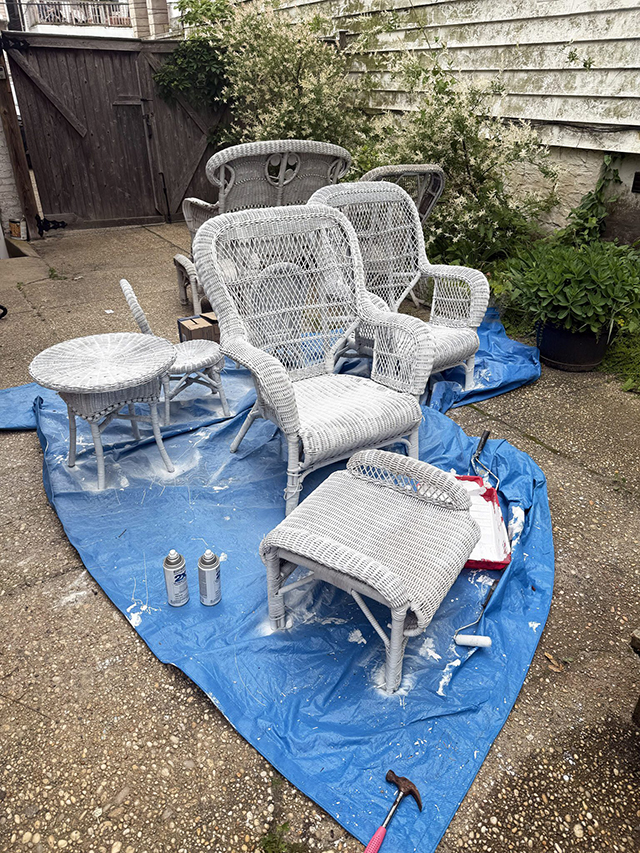
Wicker is one of the oldest furniture-making techniques in recorded history.
But then, I looked closely at my wicker loveseat and saw its spiral patterning and intricate weave that looked like thick lace with tiny imperfections. I realized – this is art, culture, and history woven together. And worth all the effort for as many years as I am able.
My next thought was, “I need to know everything about wicker.”
I assumed its origins were African—something connected to basket weaving. But no. I learned that wicker goes back 3,000 years to ancient Egypt. Archaeologists have found woven chests, baskets, and even a chair seat made of wicker buried in King Tut’s Tomb. That’s how long humans have been doing this.
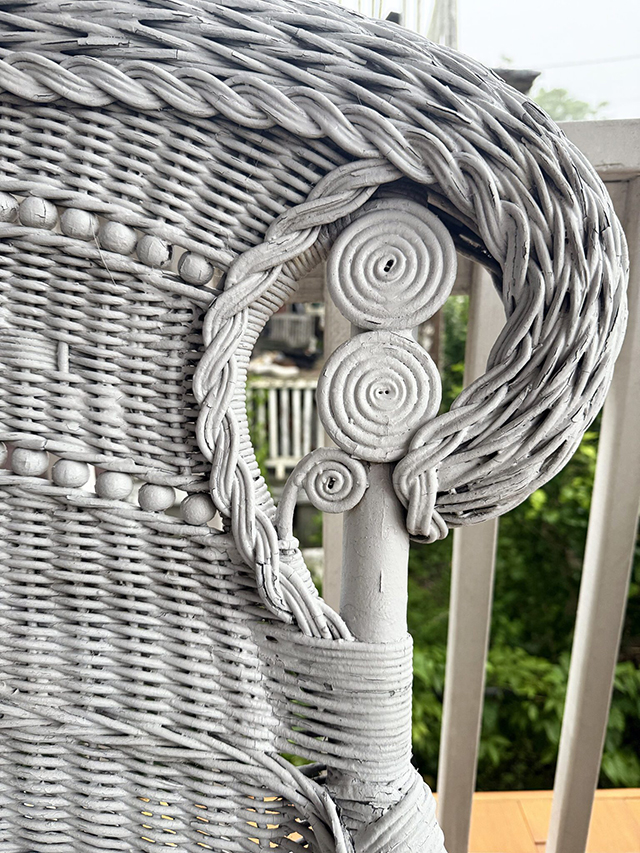
This is art, culture, and history all woven together. And worth all the effort to maintain for as many years as I am able.
I also learned, wicker isn’t a material. It’s a method – the weaving technique. The material can be rattan (palm), bamboo, willow, reed, or technically anything really. The word “wicker” is Scandinavian, meaning “to bend,” and vikker, “willow, ” meaning bendable willow.
Here’s a little timeline I pieced together from the Googlevers Wicker’s path across history:
- 3000 B.C. – Wicker weaving is invented by ancient Egyptians for functional and decorative uses. Wicker is one of the oldest furniture-making techniques in recorded history.
- 1620 – The Mayflower lands with a wicker baby cradle. Woven furniture enters America.
- 1851 – Cyrus Wakefield, “Father of the Wicker Industry,” established the Wakefield Rattan Company in Massachusetts, leading the way in bringing wicker furniture into mass production in the U.S.
- 1860–1880 – The Victorian Era was the golden age of wicker. Ornate, curvy linear designs became widely popular, especially among the upper class.
- Early 1900s – The Arts and Crafts Movement, rooted in a reaction to industrialization, gains momentum. In New England and other parts of the country, wicker furniture sees a revival as people embrace handcrafted, simple designs made from natural materials.
- 1960s – Wicker has another surge in popularity during the countercultural movement. Influenced by bohemian styles and a return to natural, earthy aesthetics, wicker became a staple in homes, sunrooms, and patios, particularly coastal regions where laid-back, eclectic design flourished.
- Mid-2000s – Synthetic Wicker becomes widely used in commercial-grade outdoor furniture. It’s valued for its durability, low maintenance, and weather resistance, but lacks the charm and history of its inspiration.
Wicker has lived many lives — and I’m learning that I have too. There’s a past that lives on my porch, and a future I’m looking forward to. And at present, a summer to enjoy. Wicker is woven into history. Into porches. Into places like our Rockaway.
Source: patioproductions.com, wikipedia.org/wiki/Wicker, wickerwoman.com
I’m so excited to share that the old potato I had sitting on my kitchen counter—the one that started sprouting—has actually started growing in my garden! Honestly, I didn’t have high hopes for it. I just threw it on the ground for fun. If you remember, I wrote about this a few weeks back: How To Grow A Potato From A Potato.
One month and a week later, the leaves are a vibrant green, sturdy, and healthy. The plant is about 4 inches tall, and at maturity, it can be as tall as 3 feet.
Now that the plant is thriving, I’m feeling the pressure to care for my potato propagation properly. So I did some digging (pun totally intended) and researched how to care for potatoes and what signs to watch for when it’s time to harvest.
I’ve gathered the helpful tips for you, whether you’re a seasoned gardener or just into potatoes.
Soil: The best soil for growing potatoes is a loose and deep loam that holds moisture and also drains well. And lots of organic matter. Luckily, for those without ideal soil, potatoes are famously hardy and adapt to many difficult soil types.
Water: Keep soil consistently moist but not soggy. Water deeply once or twice a week, especially during dry spells. Avoid overhead watering to prevent blight.
Blight: Potato blight is a fungal disease that causes dark patches on leaves and rots tubers, thriving in warm, damp conditions. To reduce the risk, try to keep the foliage dry. Harvest potatoes as soon as the foliage dies back to prevent tuber infection. Since we water bucket by bucket at the Beach 91st Street Community Garden, I’m not too worried about over watering – but it’s good to be aware of the signs, just in case.
Light: Potatoes need full sun, at least 6–8 hours of direct sunlight daily.
Hilling: When plants are about 6–8 inches tall, mound soil or straw around the base, covering the lower leaves. Repeat every few weeks to protect tubers (the potatoes) from sunlight, and this helps boost yield.

I feel hilling will be a little bit of a challenge. This is the process of mounding soil or straw around the base, covering the lower leaves to protect the potatoes and help yield more.
When to Harvest: For new potatoes, harvest 2–3 weeks after flowering. Similar to garlic, for mature potatoes, wait until the foliage turns yellow and dies back— about 120 days after planting.
Years back, I traveled to Peru and the Andes Mountains, where the potato was first domesticated by Indigenous peoples 8,000 years ago. Hearty and adaptable, potatoes have nourished civilizations for centuries. Often underestimated, they’re packed with energy-rich carbohydrates, along with vitamins C and B6, potassium, fiber, and even antioxidants—especially in the cute, colorful varieties.
I haven’t traveled to Idaho yet—the potato capital of the U.S.A.—but it’s definitely high on my list now. Why? During my potato research, I came across the most exciting place: the Idaho Potato Museum. There’s a giant potato with a pad of butter on it – out front (naturally) – and everything you could ever want to know about this amazing vegetable inside. The museum explains why Idaho is so ideal for potato growing and how the humble tuber put Idaho on the map.
Until then, I’ll be tending to my little potato patch on Beach 91st Street and dreaming of Idaho. I’ll keep you posted on the potato progress!
Source: idahopotatomuseum.com, backyardgardenclub.org, wikipedia.org/wiki/Potato
Swimmy II lives a luxurious life in my living room, in a 10-gallon oasis. He enjoys moving freely and darting around between freshwater aquatic plants and the beautiful rockscape decor I collected on the beach at 91st. Swimmy II is royal, with rich hues of deep blue, maroon, and purple. He seems to sparkle as he glides about. Swimmy is a Betta. He shares his McMansion kindly with The Slippy Brothers. It’s a symbiotic relationship. Three nerite snails slowly chow down on algae and stray bits of tank sludge, keeping Swimmy’s kingdom clean.
It’s a big job for The Brothers, but free food and rent make for a sweet deal. The plants produce organic matter, and along with remnants of Swimmy’s bloodworm feasts, debris accumulates in the tank. The Brothers do a great job, yet every month, Swimmy relies on me to change his life water. Even with a bubble maker and his snail servants, his water needs refreshing, to maintain oxygen levels and to ensure healthy water quality.
Now here’s the hack: when caring for your fish by changing a freshwater tank, consider using the spent aquarium water to water your houseplants instead of pouring it down the drain. This saves by recycling it, and it saves on plant fertilizers. Aquarium water is a rich source of nitrogen, which is what plants need to make chlorophyll, an essential component of photosynthesis. It also contains phosphorus, which supports healthy root growth, and potassium, which makes plants strong and helps them hold water. Used fish tank water also contains beneficial bacteria that break down ammonia and help feed the soil.
I use an aquarium siphon vacuum cleaner to gently suck up debris and water from the rocks. It’s simple to use and lets you target the gunk that settles at the bottom—uneaten food, plant matter, and other nutrient-rich sediment. If you don’t have a siphon, just take a wooden skewer and gently stir the gravel around. This loosens up the buildup so it can be captured when you scoop out the water. Either way, the goal is to collect the “good stuff.” Then simply use that to water your plants.
I love the idea of one living world, sustaining another, and this is exactly that.

Don’t dump it—reuse it. Spent aquarium water makes a nutrient-rich treat for your houseplants.
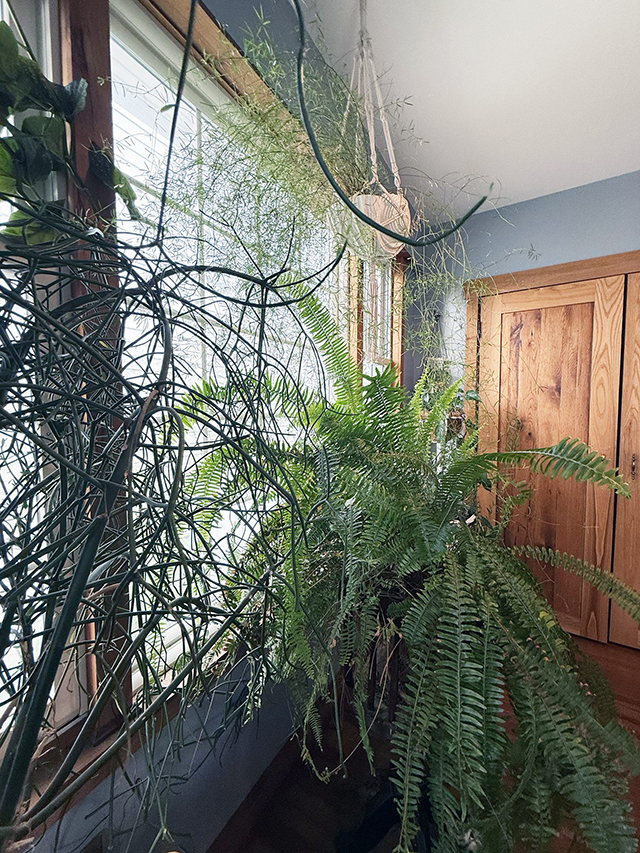
For a healthy look, rotate your houseplants slightly every two weeks for even light distribution which encourages symmetrical growth.
I know many of us are focused on our outdoor garden now, but take notice. As indoor plants wake from their winter dormancy, the increasing hours of sunlight trigger a surge in growth. In addition to regular watering and fertilizing, be sure to prune your houseplants to encourage healthy new growth. Rotate the plants slightly every two weeks for even light distribution, which encourages symmetrical growth. I also give my plants a shower—literally, in the shower. This washes away dust that has collected on the leaves, allowing for better absorption of sunlight, and it rinses off potential pests like spider mites.
Follow me on Instagram, fishing around – @theglorifiedtomato.
Source: gardeningknowhow.com










